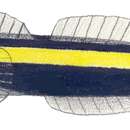Diagnostic Description
provided by Fishbase
Diagnosis: This species differs from its congeners of the Horsti complex (sensu Böhlke & Robins 1968) that have a pale stripe extending from the eye to the caudal-fin base by the following combination of characters: dark longitudinal stripe wide, reaching lower abdomen and base of anal-fin (vs. never reaching abdomen or base of anal fin); pectoral-fin rays typically 18 (vs. typically 17 in E. randalli and E. figaro and typically 16 in E. atronasum (Böhlke & Robins); anal-fin rays typically 11 (vs. typically 10 in E. figaro); oval spot present on snout (vs. no spot in E. atronasum and E. horsti (Böhlke & Robins), a "V"-shaped spot in E. prochilos (Böhlke & Robins), and a medial bar in E. xanthiprora (Böhlke & Robins), E. louisae (Böhlke & Robins) and E. lori Colin) (Ref. 52745).Description: Body naked, elongate. Mouth subterminal, no canine teeth on jaws. Dorsal fin without elongated anterior spines. Caudal fin rounded and ventral fin cup complete. Dorsal fin rays VII-11-12 (modally 12). Anal-fin rays 11. Pectoral-fin rays 17-18 (modally 18) (Ref. 52745).
- Recorder
- Estelita Emily Capuli
Morphology
provided by Fishbase
Dorsal soft rays (total): 11 - 12; Analsoft rays: 11
- Recorder
- Estelita Emily Capuli
Biology
provided by Fishbase
Found over rocky reefs and calcareous-algae banks around the island. Observed in cleaning activities during the day (and most of its life-cycle) with clients varying from large-sized carnivores such as Carcharhinus perezi (Poey) to small-sized planktivores such as Chromis multilineata (Guichenot) (Ref. 52745).
- Recorder
- Estelita Emily Capuli
Elacatinus pridisi: Brief Summary
provided by wikipedia EN
Elacatinus pridisi is a species of goby endemic to the islands of Trindade and Martin Vaz and the seamounts associated to these islands in Brazil. Like other species of the genus Elacatinus, it engages in cleaning behavior. However, unlike other cleaners, it lives in association with both sponges and Montastrea cavernosa instead of only coral. It was also recorded in association with sea urchins.
- license
- cc-by-sa-3.0
- copyright
- Wikipedia authors and editors

